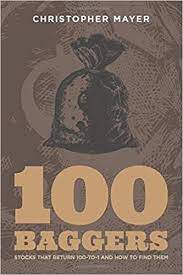
Introduction
100 Baggers is a book about how to find stocks that will give us 100-to-1 returns. This book wants to teach the readers how such returns happened and what investors need to do to find them. I was attracted by the title and also want to see what are the common themes among the 100 baggers in the book.
Author
Christopher Mayer is an author, newsletter writer, and investor. He is the portfolio manager and co-founder of Woodlock House Family Capital. Prior to that, he worked with Bonner & Partners and the Bonner family office. He was the editor of Capital & Crisis, published by Agora Financial from 2004-2015. He was a corporate banker from 1994-2004.
Content
100 Baggers has 15 chapters and an appendix.
The 15 chapters are 1) Introducing 100-Baggers, 2) Anybody Can Do This: True Stories, 3) The Coffee-Can Portfolio, 4) 4 Studies of 100-Baggers, 5) The 100-Baggers of the Last 50 Years, 6)The Key to 100-Baggers, 7) Owner-Operators: Skin in the Game, 8) The Outsiders: The Best CEOs, 9) Secrets of an 18,000-Bagger, 10) Kelly’s Heroes: Bet Big, 11) Stock Buybacks: Accelerate Returns, 12) Keep Competitors Out, 13) Miscellaneous Mentation on 100-Baggers, 14) In Case of the Next Great Depression, and 15) 100-Baggers Distilled: Essential Principles.
The appendix is The 100-Baggers (1962-2014).
Review
This book is a homage to Thomas W. Phelps who wrote the first book on 100-baggers. Phelps advocated investing in companies that do something good for mankind. He advised investors to focus on looking for new methods, new materials, and new products that improve life, solves problems, and allow us to do things better, faster and cheaper.
There are a few principles to find 100-baggers. First and foremost, we have to find a business with a high return on capital with the ability to reinvest and earn that high return on capital on years and years. By implication, these businesses should have a high growth rate. Furthermore, they should have economic moats. Let time works its magic and hold on the stocks until proven wrong. Do not try to time the market as it is a futile effort. Keep looking for great ideas instead. In investing, luck plays a role too. The author also prefers certain attributes including lower multiples (such as price-to-earnings ratio and price-to-sales ratio), smaller companies (market capitalization of less than $1 billion), and owner-operators. The twin engines of 100-baggers are growth in earnings and a higher multiple on those earnings (price-to-earnings ratio).
According to the author, true moats are rare and not easy to identify all the time. So, look for clear signs of moats in a business (otherwise, it is probably just self-deception), and also find evidence of that moat in a firm’s financial statements. The author recommends gross margin as the yardstick. The higher the gross margin relative to the competitors, the better. The author also opines In a world of monetary depreciation, asset-light company wins.
The biggest hurdle to making 100 times money in a stock is the ability to stomach the ups and downs and hold on. To counter this hurdle, the author suggests using the coffee-can portfolio. It basically means buying and holding the stocks for at least 10 years. This will protect us from the emotions and volatility that make us buy or sell at the wrong times. Netting a 100-bagger takes vision and tenacity and a conviction in an idea that may not yet be obvious in the financials. It is definitely not easy.
In 100 Baggers, the author presents insights and wisdom, not hard laws and proofs. One thing to keep in mind is that the average duration to get 100 times return is 25 years at 21% annual return, thus it is not a get-rich-quick scheme. There is no magic formula for producing 100-baggers and no easy way to screen for them. Thus, focus on opportunities that we can find, instead of playing the guessing game of market timing. The conclusion is to study markets and invest in long term enterprises which have the potential to vastly outpace other companies and industries and stick with them as long as the theme is intact.
If you want to get the gist of the book, just read the final chapter. All the preceding chapters are mostly stories that demonstrate all the principles mentioned in the last chapter. Overall, I would say this is a great book but it is not easy to implement what the author preaches.
Quotes
- A 100-bagger is the product of time and growth.
- Don’t let a seemingly high initial multiple scare you away from a great stock.
- People with their own wealth at risk make better decisions as a group than those who are hired guns.
- Over the course of an investing life, stuff is going to happen – both good and bad – that no one saw coming.
- No one creates a stock so you can make money, Every stock is available to you only because somebody wanted to sell it.
Rating

Interested in 100 Baggers?
You may get the book from Popular Online through the link below*.

One Comment
Book of the Month: July 2021 | 2bookspermonth 月读二书书评网